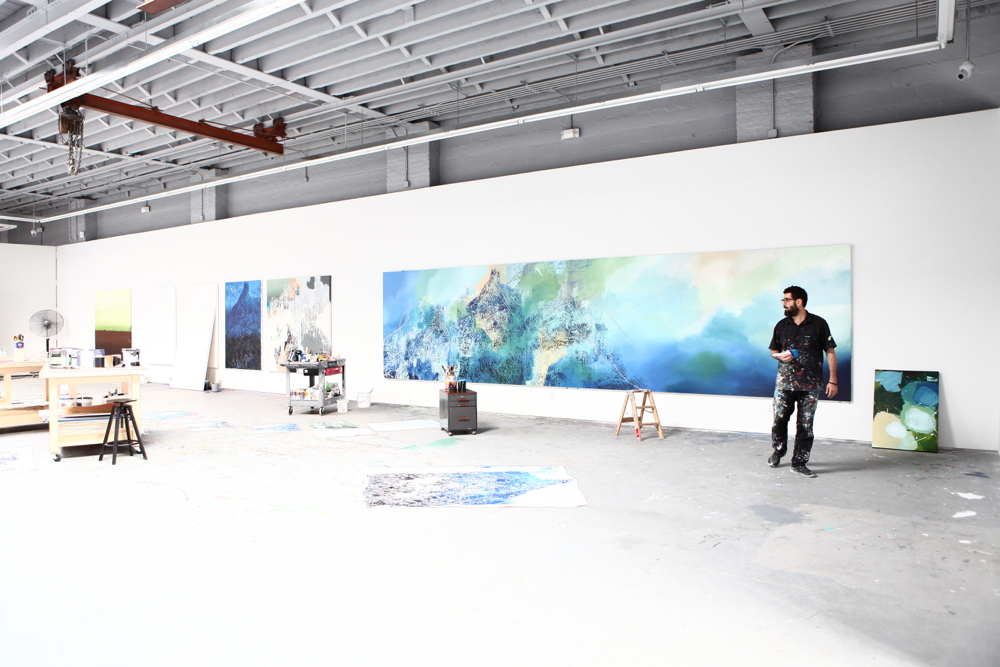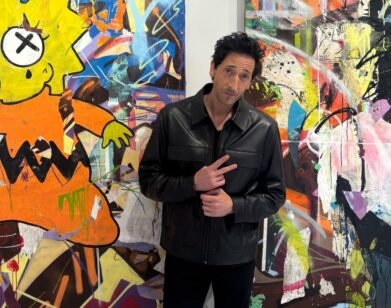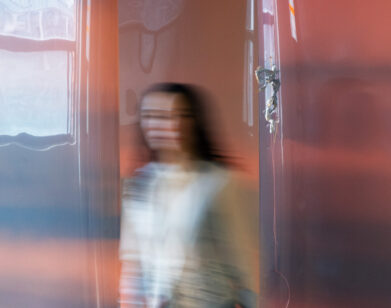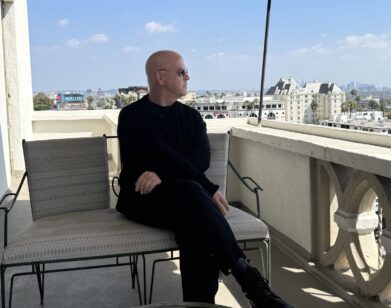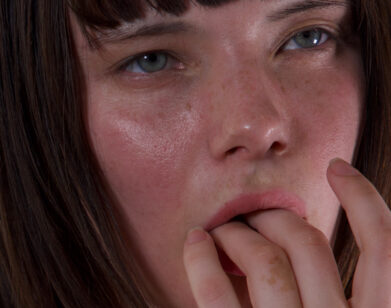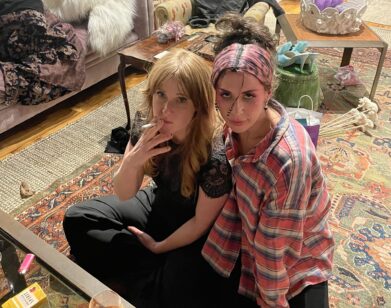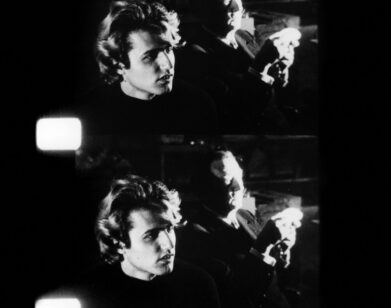José Parlá’s Sensory Exploration
You can almost hear José Parlá’s evocative paintings, like symphonies of light and color: the howls and whistles of boys playing football in the streets, the shallow breathing of a kid engraving a political slogan on a wall, the warm voice of his 85-year-old aunt in Havana, Cuba.
“The walls around us bear witness to lives past and present,” says the Brooklyn-based, 42-year-old artist, whose work embodies these multi-layered personal and political histories. “For me, the canvas is an abstract interpretation of a wall. It’s a piece of art with its own history, one that alludes to the passage of time and to the theater of life.”
Parlá was born in Miami to parents who had fled Cuba. He grew up largely in Puerto Rico, but then in the ’80s returned to Miami, where he painted on the city’s walls at night and immersed himself in hip-hop culture. Now, paying homage to this past is just as important to Parlá as stripping the labels of what is and isn’t art.
His upcoming two-part exhibit “Surface Body/Action Space,” opening this weekend at Bryce Wolkowitz Gallery in collaboration with Mary Boone Gallery, further evidences his commitment to exploring a range of subjects and themes throughout a single exhibition. New sculptural paintings speak directly to cities that shaped him and are reminiscent of previous large-scale works. Simultaneously, the canvases suggest a significant transition with receding gestural lines and expanding spaces, imbued with Parlá’s memories, conversations with artists past and present, longings, and reflections. Some even point to geo-political events, such as the 25th anniversary of the fall of the Berlin Wall and recent release of American political prisoners in Cuba.
In addition to “Surface Body/Action Space,” Parlá currently has a sculptural work on view at the Standard High Line Plaza in Manhattan, and is also the hand behind One: Union of the Senses, a permanent mural at One World Trade Center, and Diary of Brooklyn, a site-specific painting for Barclays Center. We met the artist, who has shown around the world from Tokyo to London to Havana, in his Brooklyn studio, where we shared a Cuban cigarette and walked around the works—hours before they were divided and transported to temporary new homes in Chelsea.
ANGELA LEDGERWOOD: What was the driving force behind “Surface Body/ Action Space”?
JOSE PARLÁ: I’m open to exploring many things. The sculptural paintings are inspired by the 25th anniversary of the falling of the Berlin Wall, which is this year. I want them to feel like found relics. In the Cuban community, I remember clearly how everyone felt there would be major changes in Cuba with the end of the Cold War, the collapse of the Soviet Union. There was, to some degree, because Cuba didn’t have the support and money sent by Soviet Union, but any reforms took a long time. Fidel Castro only ceded power to his brother Raul Castro in 2008. Then, on the 25th anniversary of the Berlin Wall falling, by coincidence or maybe not, President Obama announces that the United States has been in secret talks with the government of Cuba, that there are new conversations between the two governments.
This was a great moment to start a series that I’d been thinking about for a while and it was an opportunity to connect it to the High Museum [in Atlanta], the project in the Havana Biennial, and then to New York.
LEDGERWOOD: Is color an instinctual or intellectual choice for you?
PARLÁ: It’s both. Sometimes I’m inspired by a certain part of my life—I’m thinking about a place and I’ll mix the colors from memory. Sometimes I’ll reference photographs I’ve taken. Then sometimes they are intellectual. For the piece Nuevo Rumbo (New Path) I decided to go with blues and greens representative of the sky and the ocean because the painting is about the new relationship between Cuba and the United States, and about the history between the two countries, going back to before colonialism, slavery, and all that has happened until this point.
LEDGERWOOD: And your preoccupation with walls?
PARLÁ: When I was young I was constantly reading walls; I took in everything written on walls, from love messages to political messages. It was my hobby and became my art. When I went to college at Savannah College of Art and Design a lot of the teachers weren’t receptive to my work, which was inspired by the walls of the city. One teacher told me that my work belonged in the trash. That day I ran out of the classroom and ended up in the library, where there happened to be a black and white photography exhibition of Robert Rauschenberg’s photographs of the streets of New York. The subject of his photos were exactly what I was painting about. There was one small picture of an interior of the studio that Rauschenberg and Cy Twombly shared, so I discovered both of their works at the same time. I found books about them and that lead me to Antoni Tàpies and Joan Mitchell.
I used those books as my weapons. I armed myself and I went right back to the class and I put the books on the teacher’s desk, and I said, ‘How come you didn’t tell me about these artists? How is what I’m doing so different to what these guys are doing?” He was impressed. I felt a linear connection to the Abstract Expressionists and this opened up my work to what was going on in the recent history of painting.
LEDGERWOOD: Why do you dislike it when people call art on walls “street art”?
PARLÁ: People have been making marks on walls since the beginning of time, starting with cave paintings. In the 1930s, the Hungarian photographer Brassaï photographed all these scratchings and little faces engraved on walls. He also interviewed Joan Miró and Picasso about wall writing and Picasso said they he used to paint on walls… Sophie Calle was using the writing she found on walls and incorporating that into her work, so it had been going on for years. But suddenly when it was attached to the so-called graffiti subculture it was not worthy and was excluded from the institutions, including the schools.
In 1984 I remember going to an exhibition that was labeled “street art” and thinking how much I didn’t like that title. It felt like journalists at the time needed a way to categorize it, so they just stamped it with the terms “street art” and “graffiti art.”
LEDGERWOOD: Do you ever feel like you’re abandoning your roots as your style develops?
PARLÁ: I never want to abandon my roots. I want to give my past and the history of painting the importance it deserves, including the masters like Rembrandt, who built up the surface of the canvas with transparent layers. I want to pay respect to calligraphic writing, and the drip, and everything you might see as decay, deterioration or even vandalism. I frame and present it as art. My work is an exploration of the self. I’ve always been concerned with how I’m living and how that reflects in the painting.
LEDGERWOOD: You use a very gestural language. How did that start?
PARLÁ: My paintings tell stories. In 2006, I did a painting called Brothers Back to Back, where I wrote out layers and layers of stories about my brother and I as teenagers and how we got into art and how we survived pretty mean streets and tough situations. I celebrated that. It also talks about the music we were listening to at the time.
I layered all the writing so it was illegible so it could become the story of the viewer. That came from imagining how memory must be stored in our mind, like in these clear layers. You try to tap into a memory and you close your eyes and it comes back. So I was doing this in the painting and then that became a practice of mine. Sometimes it was a cathartic situation, a way to meditate.
My style also has a lot to do with theater because often I’m imagining I’m a character who is wandering by a wall and leaves a mark. Then I’m someone else, who 10 days later leaves another mark. Someone was angry and did this, and then someone came and painted over it, and then the sun bleached it out and the weather exposed it again.
LEDGERWOOD: Do you find the physical process exhausting?
PARLÁ: I have too much energy, even for myself. I’m lucky to have something that focuses me. If I’m going through something, I paint through it. It’s very physical. I’m writing, I’m thinking, I’m meditating, I’m moving, I’m jumping off ladders, and it’s therapeutic. Sometimes I’m not so sure how healthy it is because it’s exhausting to put all your emotion into your work, but I guess I should be thankful for that. I don’t want the work to be about anything else but the truth and honesty.
LEDGERWOOD: How important is music in your work?
PARLÁ: As a young kid I was in love with breakdancing. I practiced the uprock style, which is a battle style of dance that looks like fighting. It comes from the gangs in New York in the 1960s and ’70s. It’s beautiful, almost like a martial art, and it can be funny, too, because you make fun of each other. I did it for over 25 years. Sometimes I do it in the studio when I’m playing music to get my body warmed up. A lot of that energy ends up in the artwork because I have the agility to jump from one side of the painting to the other. People have thought that some of my writing and lines are done by a machine. I’m able to move in a way that’s part gestural dance performance, and it’s fun for me, so I incorporate that into the painting.
LEDGERWOOD: Is each painting representative of a specific moment or place?
PARLÁ: Yes. For example, Tomando Café con un Abakuá’ (drinking coffee with an Abakuá’) is about a moment that happened in Cuba a few years ago when a neighborhood gentleman bought me a coffee because I had run out of Cuban pesos. As we were having our coffee together a little boy whispered into my ear, “He’s an Abakuá.” Then he ran off. An Abakuá is a member of a special Afro-Cuban secret society. They are the guardians of the African cultures in Cuba, related to the music, the Rumba, the dances, and drums. I said to the gentleman, “I’ve heard of the Abakuás. Tell me, what does it mean to you?” He said, “To be an Abakuá you have to be a good son and a good father.” This was a story I wanted to tell through a painting. The colors are the colors of that neighborhood, the specific street, and of the man himself.
LEDGERWOOD: The mural commission for One World Trade Center took you a year. How did that experience affect you?
PARLÁ: Being chosen was a huge honor as a New Yorker and as someone who saw the towers fall from Brooklyn on September 11. Once I built the 90-foot canvas I stood in front of it and thought, “What am I going to do?” I didn’t want it to be about the past or the attacks; I wanted it to be a love letter to the diversity of New York so I equipped myself with the opportunity to mix every single color. It started out quite minimal with the sky, mountains, hills, and valley, and then I started to fill it in with people and all that noise—the moving and the buzzing—the chaotic symphony of what New York is. The colors were about bursts of energy. I wrote the names of communities in Brooklyn, Manhattan, and the Bronx—of countries, people, artists, whatever came to mind. Though, it’s not about reading it; it’s about feeling the language.
Throughout the months I kept feeling this buzz. Then one day I felt like I was in a trance, like I was at one with the paint and the color—almost like I could taste it with my eyes or touch it with my hearing. It was this mixing of the senses. I started researching what this feeling could be about and it lead me to the study of synesthesia, which is the union of the senses. I thought, “That’s it, that’s what I’m painting.” On an even deeper level it’s about being at one with yourself—that’s how the title came to me, One: Union of the Senses.
LEDGERWOOD: Do you think artists should speak about their work or let the art speak for itself?
PARLÁ: Sometimes I think I shouldn’t explain so much about my work because people will just feel what they feel when they see it. They’ll love it or hate it or enjoy it on their own, like how I’ve looked at abstract paintings of other artists and cried or felt happy because I’ve felt, “Wow, I’ve lived that, I’ve understood that.” But at the same time, I think artists should define themselves. They should speak about their work and how it relates to society and what’s going on in the world.
“SURFACE ACTION/BODY SPACE” OPENS SEPTEMBER 12 AND WILL BE ON VIEW THROUGH OCTOBER 31. FOR MORE ON THE ARTIST, VISIT HIS WEBSITE.

